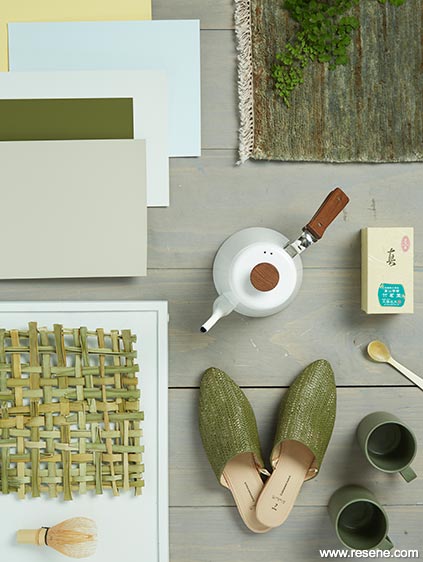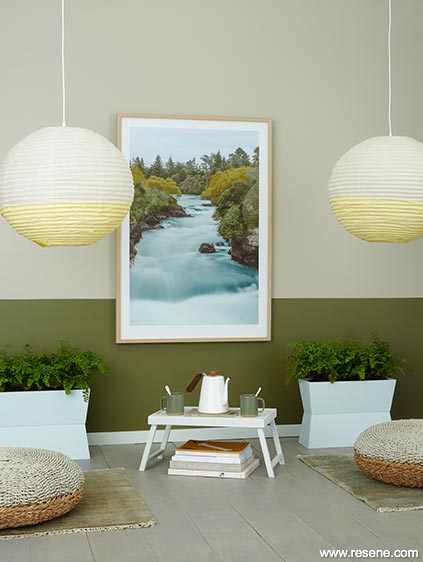From the Resene colour inspiration – latest looks gallery
Everything feels right in a space when each of the elements within it have been properly balanced.
Just as when we are off balance in various aspects of our lives, an unbalanced interior can be uncomfortable. There are instances when this is the desired effect, but for the majority of spaces, visual balance is the goal. In fact, balance is one of the major guiding principles of interior decorating.
Balance can be achieved in a number of ways by distributing the ‘visual weight’ of objects – the space within our frame of vision – within a room to achieve a sense of equilibrium. The size, colour, texture and shape of an element can change its visual weight. For example, larger, darker, brighter, highly textured and/or complexly shaped objects typically feel heavier and require balance through the placement equally ‘heavy’ items or a cluster of less heavy items.




Symmetrical balance is achieved when items are actually repeated or mirrored along a central axis. This type of balance is frequently seen in nature, our own bodies included. Symmetry is common in interior design and can portray a feeling of stability, calmness and dignity, and it can be achieved through the use of pattern, arrangement of furnishings and through the application of colour.
While the literal symmetry of the physical elements in this tea room certainly add to its zen-like appeal, soft and restful tonal greens layered with notes of pale blue and straw yellow are also a major factor in the balance that exists in this space. The upper section of the wall, which is painted in Resene Eagle, meets a section of earthy Resene Waiouru not far from the floor. When you look at it straight on, this horizon line cuts through the space at approximately one third of the way up the wall – and by painting the area in a darker colour, it grounds the space. Proportionally, it creates a different type of balance: asymmetrical.


The furnishings, too, have been kept low to the floor including the twin planter boxes painted in Resene Cut Glass and the round woven seagrass cushions, the tops of which have been painted Resene Eagle to reflect both the colour and line of the wall behind. Similarly, repetition of this same horizon or ‘tide line’ has been brought up on to the rice paper pendant lanterns, with bottoms painted in Resene Sweet Corn.
While strong horizonal lines are prevalent, it’s the artwork – perfectly centred within the greater space – that breaks up this continuity through its strong vertical lines that dip below the horizon, creating a strong focal point. However, because the line across the wall meets it at one third of the way up, it subconsciously builds upon the sense of repetition while still being a point of difference.
Natural textures, such as the wood grain of the timber floor, which is finished in Resene Colorwood Mid Greywash, woven mats and sea grass cushions create more subtle repetition, as do the fresh plants and the skirting board painted Resene Cut Glass, which play off of the shapes and colours in the artwork, and the Resene Waiouru tea cups and slippers. Each helps to bring hues off the walls and into the space itself, creating the sensation that you are playing first hand witness to the beauty of the waterfall in the photograph.
Accessories: Round Pillow Seagrass Pouf from Nood; Armadillo & Co Egyptian Aegean Rug from The Ivy House; Shoes, tray and planter boxes from Kmart; Paper Lanterns from Trade Aid; Teapot from Everyday Needs; Hukanui Photographic print by Rakai Karaitiana from endemicworld; Green Mugs and Wabi Sabi book from An Astute Assembly.

Styling by Kate Alexander. Photography by Bryce Carleton. 2020
Colour inspiration - latest looks gallery
Get inspired with colour and the latest decorating and colour trends! Select just the right look and mood for your space.
Filter: kids & teens | greens | blues | yellows | neutrals | oranges/browns | pinks/reds | greys/blacks | violets | pops-of-colour/multi-colour
Home solutions
Home office, hidden mural, storage
Eighties for the twenties
With the cyclic nature of design...